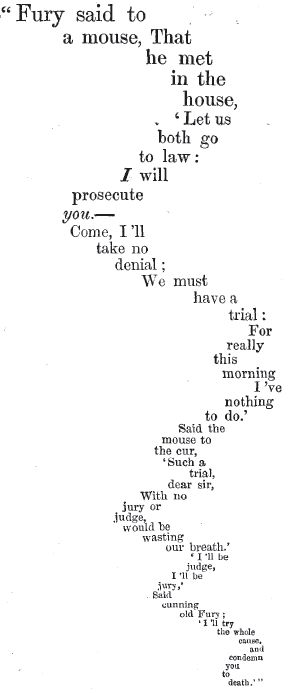Module 4: Poetry
3. Lewis Carroll: “The Mouse’s Tale” #
The following example is an excerpt from Lewis Carroll’s “The Mouse’s Tale,” a poem appearing in the third chapter of Alice in Wonderland. It is a concrete poem in which the lines consist of only a couple of words, laid out in such a way that they visualise the mouse’s winding tail:
For the encoder, this specific visual layout challenges the TEI’s orientation to logical structures. In the example, the visual lines are encoded as logical lines (<l>); the visual particularities (font size, indentation) are formalised as values of a @rend attribute on each line. Of course, any value system is allowed for the @rend attribute; it’s up to the processing layer to decide how to interpret these values and format them on the screen / in print.
Reference
Since version 2.0, the TEI Guidelines have added a <sourceDoc> element, that allows for a topographic transcription of the content of primary manuscripts, organised in visual units <surface>, <zone>, and <line>. See chapter 11. Representation of Primary Sources of the TEI Guidelines.Alternatively, the lines could have been treated on a more logical level, spanning multiple physical lines. The line breaks then could have been encoded with <lb> elements, and specific visual characteristics as values for @rend attributes on <seg> elements. Since the white space is quite significant, the special-purpose TEI element <space> could have been used as well.
Bibliography
- Blake, William. 1789. Songs of Innocence and of Experience. London: W Blake. Encoded and made available by the University of Virginia Library, Text Collection at https://etext.lib.virginia.edu/toc/modeng/public/BlaSong.html.
- Browning, Robert. 1842. Dramatic Lyrics. London: Moxon.
- Carroll, Lewis. 1865. Alice’s Adventures in Wonderland. New York: D. Appleton and co. p. 37.
- Islam, Mubina. 2004. “A Selection of Sonnets: electronic edition encoded in XML with a TEI DTD.” Unpublished Master’s Dissertation, London: University College London.
- Shakespeare, William. 1978. The Complete Works of William Shakespeare. Edited by Alexander, Peter. London: Collins.
- Swinburne, Algernon Charles. 1924. Swinburne’s Collected Poetical Works. London: William Heinemann. p. 330–31.



